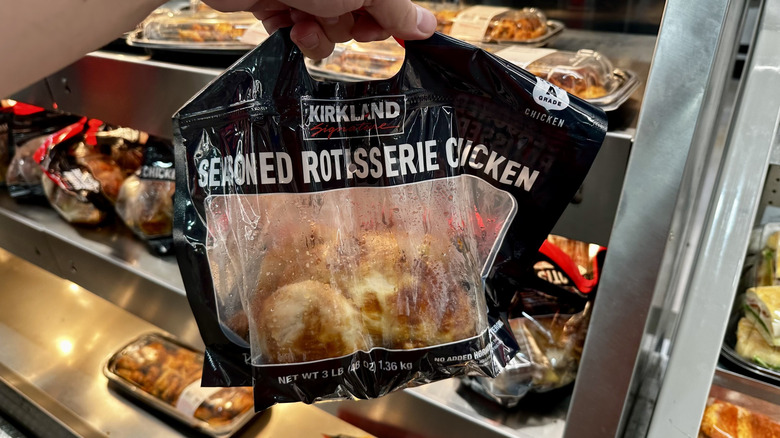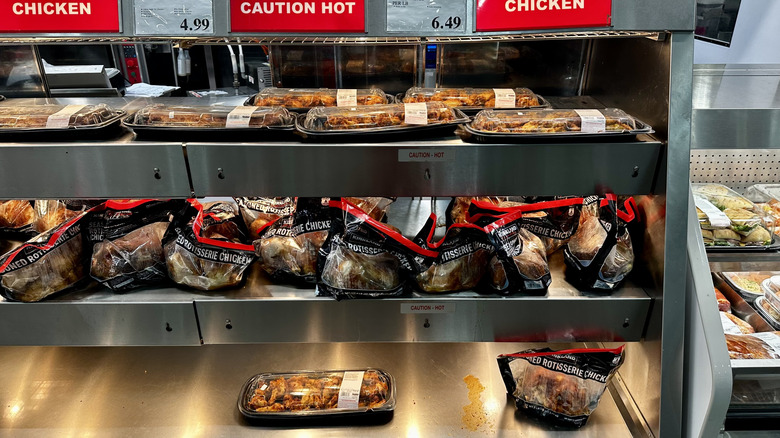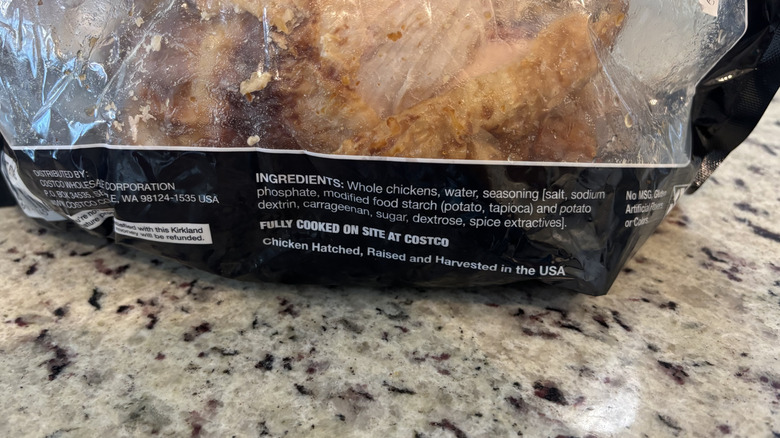Have you ever grabbed a rotisserie chicken from Sam’s Club and wondered exactly where that juicy bird came from? I’ve been curious about this myself, especially since my family goes through Sam’s Club chicken like there’s no tomorrow The truth is, the journey from farm to your shopping cart is more complex than most people realize
As a frequent Sam’s Club shopper, I decided to dig deep into their chicken supply chain to understand exactly what we’re eating. What I discovered was fascinating – a massive integrated system that spans multiple states and involves some of America’s largest poultry producers.
The Chicken Supply Chain: A Massive, Integrated System
Sam’s Club doesn’t raise chickens themselves – no surprise there! Instead they source their poultry from several major suppliers
- Tyson Foods – One of the primary suppliers
- Pilgrim’s Pride – Another major chicken provider
- Perdue Farms – Also supplies chicken to Sam’s Club warehouses
These giant poultry companies contract with thousands of independent farmers throughout the country, primarily concentrated in states with established poultry farming infrastructure:
- Arkansas
- Georgia
- Alabama
- Mississippi
- North Carolina
The relationship between these poultry giants and local farmers is what industry insiders call an “integrated” system. Here’s how it works:
- The poultry company provides chicks, feed, and medication to contracted farmers
- Farmers raise the chickens according to strict company specifications
- Once the chickens reach market weight, they’re transported to processing plants
- The chickens are processed into various cuts (whole, breasts, thighs, etc.)
- The finished products are shipped to Sam’s Club distribution centers
- Finally, they reach individual Sam’s Club warehouses across the country
This tight integration gives companies like Tyson Foods enormous control over the entire process. It ensures consistency and keeps costs down, but it also raises some important questions.
Quality and Ethical Concerns: What You Should Know
When food is produced at such a massive scale, quality and ethical concerns naturally arise. Here’s what you should know about Sam’s Club chicken
Quality Control
Sam’s Club relies heavily on the quality control measures of its suppliers. These major poultry companies typically have stringent protocols around safety and hygiene. All chicken sold at Sam’s Club undergoes inspection by the USDA Food Safety and Inspection Service to ensure it meets requirements.
However, concerns persist about antibiotic use in the industry. While some poultry companies have reduced or eliminated antibiotics considered “critically important” for human medicine, others still use them to prevent disease in densely packed chicken houses.
Animal Welfare Issues
Let’s be honest – the living conditions for chickens in industrial farming aren’t great. Typically, these birds are raised in large, enclosed houses with thousands of other chickens. They have limited ability to engage in natural behaviors, which has drawn criticism from groups like the American Society for Prevention of Cruelty to Animals (ASPCA).
The chickens that end up at Sam’s Club generally have:
- Limited space to move around
- Little to no access to the outdoors
- Restricted ability to engage in natural behaviors
These intensive farming practices prioritize efficiency over animal welfare, which is something to consider when making purchasing decisions.
Environmental Impact
Large-scale chicken production has a substantial environmental footprint:
- High water usage
- Greenhouse gas emissions
- Waste runoff that can contaminate local water sources
Some poultry companies are working to reduce their environmental impact through renewable energy use and improved farming practices, but the overall industry still faces significant sustainability challenges.
Transparency Challenges
One of the most frustrating aspects for conscious consumers is the lack of traceability. It’s virtually impossible to trace a specific piece of Sam’s Club chicken back to the individual farm where it was raised. The integrated production system often involves mixing chickens from multiple farms during processing.
The most you’ll typically find on packaging is information about the poultry company that supplied the chicken, not the specific farm.
Answering Your Burning Questions About Sam’s Club Chicken
After researching Sam’s Club chicken sourcing, I’ve put together answers to the most common questions shoppers have:
Is Sam’s Club chicken organic?
No, the majority of Sam’s Club chicken is conventionally raised without organic certification. While they occasionally offer organic options, these are limited and typically more expensive.
Does Sam’s Club chicken contain hormones or steroids?
No. It’s actually illegal in the United States to use hormones or steroids in poultry production. So, all Sam’s Club chicken (and all chicken sold in the US) is free from added hormones and steroids. When you see “no hormones added” on packaging, it’s technically true but also a bit of marketing fluff since it applies to all chicken.
Is Sam’s Club chicken treated with antibiotics?
This is trickier. Some Sam’s Club chicken may be treated with antibiotics to prevent disease, although reduced use is becoming more common in the industry. If you’re concerned about antibiotic use, look specifically for labels that say “no antibiotics ever” or “raised without antibiotics.”
What are the chickens’ living conditions like?
The typical conditions are enclosed houses with thousands of other chickens and limited ability to engage in natural behaviors. This intensive farming approach prioritizes efficiency and cost-effectiveness over what many would consider humane treatment.
Is any of Sam’s Club chicken pasture-raised?
No, Sam’s Club chicken is generally not pasture-raised or free-range. These labels would indicate that the chickens had access to the outdoors and could engage in more natural behaviors. The standard chicken at Sam’s Club comes from conventional indoor farming operations.
Can I trace the chicken back to a specific farm?
Unfortunately, end-to-end traceability from store to farm is not currently possible with Sam’s Club chicken. The best you can do is check the packaging for information about the supplying poultry company.
Is Sam’s Club chicken air-chilled?
Some locations may offer air-chilled chicken, depending on regional supply and preferences. Air-chilled chicken is cooled using cold air instead of water, which proponents argue results in better taste and texture. Check the packaging to confirm the chilling method used.
How does the price compare to other stores?
Sam’s Club frequently offers competitive bulk pricing on chicken due to its purchasing power. This is one of the main attractions for many shoppers. Their rotisserie chickens, in particular, are known for being a good value, though prices may vary by location.
Comparing Sam’s Club and Costco Rotisserie Chicken
I recently did a taste test between Sam’s Club and Costco rotisserie chickens to see how they stacked up:
Nutrition Information
- Both chickens contain about 140 calories per serving
- Both have 7 grams of fat and 19 grams of protein
- Costco’s chicken has 460 mg of sodium, while Sam’s Club has 430 mg
Taste and Texture
Costco’s chicken had a slight crunch to the skin and exceptionally juicy meat. The seasoning was well-balanced, enhancing rather than masking the chicken flavor.
Ingredients and Additives
Costco’s chicken has a simpler ingredient list but contains carrageenan, a thickening agent that some people prefer to avoid due to potential digestive issues. It’s commonly found in many processed foods, including nut milks.
Making Informed Choices at Sam’s Club
If you’re concerned about the sourcing of your chicken, here are some tips for shopping at Sam’s Club:
-
Look for specific labels: Terms like “no antibiotics ever,” “certified humane,” or “animal welfare certified” indicate higher standards.
-
Consider organic options when available, though they’ll be more expensive.
-
Ask questions: Don’t hesitate to inquire with store management about their chicken sourcing practices.
-
Balance priorities: Decide what matters most to you – price, quality, ethics, or environmental impact – and shop accordingly.
-
Explore alternatives: If Sam’s Club chicken doesn’t meet your standards, consider local farms, farmers markets, or specialty retailers that offer more transparency.
I’ve found that most of us need to balance our ideal food standards with practical considerations like budget and convenience. For my family, Sam’s Club chicken remains a good value, but I’m more aware now of where it comes from and the systems that bring it to my table.
The Bottom Line
Sam’s Club chicken comes from a network of large poultry producers like Tyson Foods, Pilgrim’s Pride, and Perdue Farms, who contract with thousands of independent farmers across the country. This integrated system prioritizes efficiency and consistency but raises questions about animal welfare, environmental impact, and transparency.
While the chicken undergoes strict quality control and safety inspections, it’s typically not organic, pasture-raised, or produced with the highest animal welfare standards. The price, however, is often more competitive than other retailers due to Sam’s Club’s purchasing power.
As consumers, we have the power to influence the market through our purchasing decisions. By demanding more transparency and higher standards, we can gradually shift the industry toward more ethical and sustainable practices.
Have you ever thought about where your Sam’s Club chicken comes from? Does knowing the source affect your purchasing decisions? I’d love to hear your thoughts!

What is a grocery store rotisserie chicken?

All rotisserie chickens are roasted, but not all roasted chickens are rotisserie. The biggest difference is the movement of the chicken during the roasting process. Rotisserie chicken rotates around, cooking evenly throughout, but a roasted chicken, like a chicken you might prepare in your oven at home, gets put in a pan and then sits, stationary, in your oven. There is no constant rotation here.
At many grocery stores, youll find rotisserie chickens in the deli. At some stores, like Walmart, Target, or Publix, these rotisserie chickens are made only a couple birds at a time. At larger warehouse stores like Sams Club and Costco, rotisserie chickens are made on such a large scale, its something of a spectacle to behold.
My family has been enjoying home-cooked roasted chicken with veggies as one of our go-to meals, and while its delicious, especially when cooked with veggies in the pan, its a long cook for a weeknight (or any night) of dinner. Thats one of the reasons that a grocery store rotisserie chicken is just so beloved. Theres no prep time, and you have dinner nearly ready as soon as you check out.

Rotisserie chickens from Costco and Sams Club are something of a staple item. Youd be hard-pressed to visit either store without seeing each one with fully stocked warming shelves absolutely full of rotisserie chickens.
If youre a member at either location, you can get the chickens for their listed price. Costcos in-store rotisserie chicken price is $4.99. Not to be outdone, Sams Club offers it for ever so slightly less, at $4.98, making it the cheaper of the two warehouse store rotisserie chickens.
While I am a Costco member, I am not a Sams Club member, so I needed to order my Sams Club chicken through Instacart. At my location, this meant I paid $6.32 for the chicken, more than a fourth as much more. If I werent a Costco member, my price would have been higher there, too, at $6.21, slightly less than a fourth as much more.
Nutrition information and ingredients

Between the two rotisserie chickens, the nutritional differences arent anything substantial. Both chickens come in at 140 calories with 7 grams of fat and 19 grams of protein. The only place they differ is in the sodium numbers. The Costco bird has 460 milligrams of sodium, and Sams Club has 430 milligrams. The difference in your recommended daily intake is only 1%.
In terms of ingredients, there is slightly more variance. While the Costco bird has a simpler ingredient listing, it has one ingredient that may be a little concerning to some: carrageenan. Its intent is to thicken or even provide preservative quality to food. For some, it will be important to note that although the additive is very common, often in other meat products and even nut milks, it may have some concerning effects on your digestive system.
Sam’s Club Seasoned Rotisserie Chicken Review
FAQ
Where does Sam’s Club chicken come from?
It‘s also possible that Sam‘s Club sources some of its chicken from other major producers like Pilgrim‘s Pride, Perdue Farms, or Sanderson Farms. However, Tyson‘s market dominance and Walmart ties still make it the most likely primary supplier in my estimation.
Does Sam’s Club sell member’s Mark chicken?
If you‘re a regular Sam‘s Club shopper, you‘re probably familiar with the Member‘s Mark brand. This private label offers a wide variety of food and household products, often at lower prices than name brand equivalents. Member‘s Mark has become especially known for its fresh meat, including an extensive lineup of chicken products.
Where does Sam’s Club meat come from?
**Sam’s Club sources its meat from a variety of suppliers across the United States and even from other countries.** Sam’s Club, being a wholesale retailer, has an extensive network of suppliers to meet the high demand for their meat products. They work closely with reputable suppliers who follow strict quality and safety standards.
What makes Sam’s Club chickens unique?
Here‘s a rundown of the key attributes that Sam‘s Club specifies: No antibiotics: Member‘s Mark chickens are raised without any antibiotics, including for growth promotion or disease prevention. This is a major selling point at a time when consumers are increasingly concerned about overuse of antibiotics in animal agriculture.
Does Sam’s Club sell private label chicken?
In 2019, private label captured 26% dollar share and 41% volume share of fresh chicken sales in U.S. supermarkets. ^19 Member‘s Mark is a top player in this space thanks to Sam‘s Club‘s wide reach and reputation for quality. For consumers, private label chicken products offer cost savings without sacrificing taste or safety.
Does Sam’s Club have organic chicken?
Yes, Sam’s Club offers organic chicken among their meat selections. You can find various cuts and types of organic chicken to suit your needs. 10. Is Sam’s Club meat fresh? Sam’s Club takes pride in delivering fresh meat to its customers. They work closely with suppliers and prioritize maintaining the freshness of their products. 11.
Who supplies Sam’s Club chicken?
Does Sam’s Club meat come from China?
Sam’s Club
Both big-box grocery stores have similar selections, although Sam’s Club tends to have higher quality cuts of meat available for consumers. Sam’s Club sources its meat from within the United States and Australia.
What brand is Sam’s Club rotisserie chicken?
Member’s Mark Seasoned Rotisserie Chicken. Prices may vary in club and online. Get a $30 as a statement credit when you open a new account and make $30 in Sam’s Club purchases within 30 days¹.
Where does Sam’s Club get their produce from?
Fresh America is now completely responsible for the produce departments in 190 Sam’s Clubs. The new contract will nearly double the number of club stores that Fresh America supplies, bringing the total to 372, while eliminating the supplier’s operational responsibilities within Sam’s.
